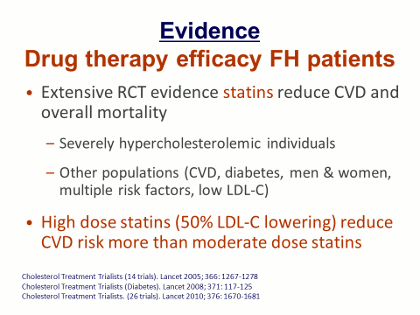Robinson - Figure 5 - Evidence for #2 Text
There is an extensive body of evidence, from >26 trials and >170,000 people, that statins reduce the morbidity of CHD and moreover reduce CHD mortality in high-risk populations. So there is really no controversy around advocating a regimen of statin therapy as the approved strategy for initial treatment for all adults with FH, with the mandated goal of achieving a reduction of ≥50% in serum LDL cholesterol. Achievement of this goal will often require administration of a high-dose and/or high-potency statin, although if a person does achieve an LDL reduction of ≥50% on a moderate dose of an older, cheaper, generic statin, then that is counted as “success.”
Because of the relative paucity of FH patients recognized in the general population (the incidence of heterozygous FH is approximately 1 in 500), this poses a challenge for basing treatment of FH strictly on trial-based evidence in defined FH populations. On the other hand, we do have a quite extensive data set available from trials in severely hypercholesterolemic individuals, many of whom did have FH but who were enrolled at a time when FH was not a study entry criterion. Two of the earliest trials of statin therapy were the Scandinavian Simvastatin Survival Study (4S)[6] and the West of Scotland Coronary Prevention Study (WOSCOPS),[7] both of which reported significant reductions in mortality, not just CHD mortality but total mortality as well, with statin therapy. A later study, the Heart Protection Study (HPS)[8] demonstrated the benefit of statin therapy even in patients with “normal” LDL cholesterol levels, and in much more recent trials (Treating to New Targets [TNT],[9] PROVE IT-TIMI 22[10]) it was found that using statin therapy to lower serum LDL cholesterol levels to unprecedentedly low levels brought further morbidity and even mortality benefit over treatment to less extremely low levels.
Against this very robust background demonstrating the benefits of treating patients to achieve very low serum LDL cholesterol levels it was noted that treatment with high-dose, high-potency atorvastatin reduced serum LDL cholesterol by about 50%, and therefore that is the basis for the recommendation that the goal in FH patients should be to aim for an LDL reduction of at least a 50%.
J Clin Lipidol. 2011; 5(6).References
[6]The Scandinavian Simvastatin Survival Study Group. Randomised trial of cholesterol lowering in 4444 patients with coronary heart disease: the Scandinavian Simvastatin Survival Study (4S). Lancet 1994; 344: 1383-1389.
[7]Shepherd J, Cobbe SM, Ford I, et al, for the West of Scotland Coronary Prevention Study Group. Prevention of coronary heart disease with pravastatin in men with Hypercholesterolemia. NEJM 1995; 333: 1301 – 1307.
[8]Heart Protection Study Collaborative Group. MRC/BHF Heart Protection Study of cholesterol lowering with simvastatin in 20 536 high-risk individuals: a randomised placebo controlled trial. Lancet 2002; 360: 7–22
[9]LaRosa JC, Grundy SM, Waters DD, et al. Intensive Lipid Lowering with Atorvastatin in Patients with Stable Coronary Disease. N ENgl J Med 2005; 352:
[10]Cannon CP, Braunwald E, McCabe CH, et al. Intensive versus Moderate Lipid Lowering with Statins after Acute Coronary Syndromes. N Engl J Med 2004; 350:1495-504.
